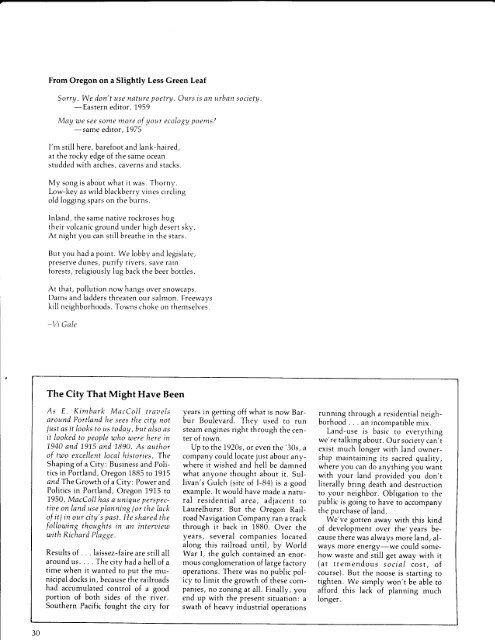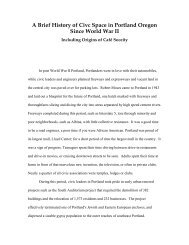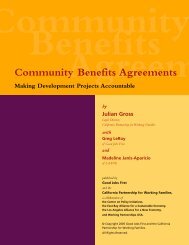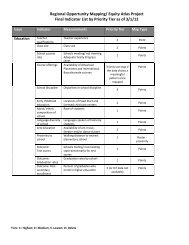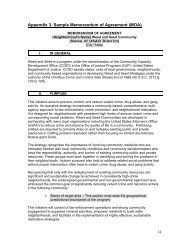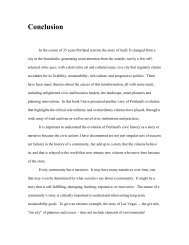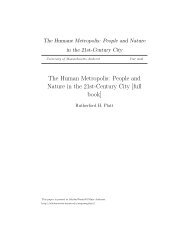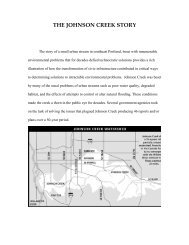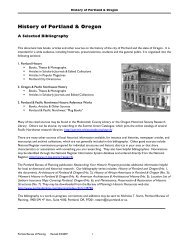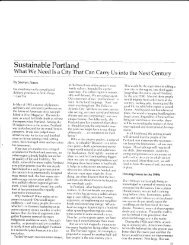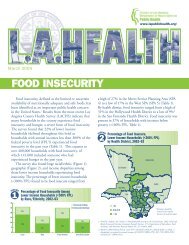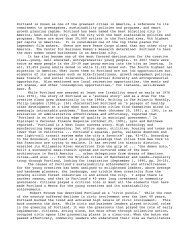The City That Might Have Been - Steven Reed Johnson
The City That Might Have Been - Steven Reed Johnson
The City That Might Have Been - Steven Reed Johnson
Create successful ePaper yourself
Turn your PDF publications into a flip-book with our unique Google optimized e-Paper software.
From Oregon on a Slightly Less Green LeafSorry. We don't use nature poetry. Ours is an urban societv.-Eastern editor, 1959May we see some more of ,,1our ecolog,y poemsl-same editor, 1975I'm still here, barefoot and lank-haired,at the rocky edge of the same oceanstudded with arches, caverns and stacks.My song is about what it was. Thorny.Low-key as wild blackberry vines circlingold logging spars on the burns.Inland, the same native rockroses hugtheir volcanic ground under high dcsert sky.At night you can still breathe in the stars.But you had a point. We lobby and legislate,prcserve dunes, purify rivers, save rcinforests, religiously lug back the beer bottles.At that, pollution now hangs over snowcaps.Dams and ladders threaten our salmon. Freewavski11 neighborhoods. Towns choke on themseivei.-Vi Gale<strong>The</strong> <strong>City</strong> <strong>That</strong> <strong>Might</strong> <strong>Have</strong> <strong>Been</strong>As E. Kimhark MacColl traztelsaround Portland he sees the citv notjust as it Iooks to us today, but also asit looked to people who were here in7940 and 7915 and 1890. As authorof two excellent local histories, <strong>The</strong>Shaping of a <strong>City</strong>: Business and Politicsin Portland, Oregon 1885 to 1915and<strong>The</strong> Growth of a <strong>City</strong>: Power andPolitics in Portland, Oregon 1915 to7950, MacColl has a unique perspectitteon land use planning (or the lackot' it) tn our city's past. H e shared thefollowing thoughts in an interaiewwith Richard Plagge.Results of . . . laissez-faire are still allaround us. . . . <strong>The</strong> city had a hell of atime when it wanted to put the municipaldocks in, because the railroadshad accumulated control of a goodportion of both sides of the river.Southern Pacific fought the city foryears in getting off what is now BarburBoulevard. <strong>The</strong>y used to runsteam engines right through the centerof town.Up to the 7920s, or even the'30s, acompany could locate just about anywhereit wished and hell be damnedwhat anyone thought about it. Sullivan'sGulch (site of I-84) is a goodexample. It would have made a naturalresidential area, adjacent toLaurelhurst. But the Oregon RailroadNavigation Company ran a trackthrough it back in 1880. Over theyears, several companies locatedalong this railroad until, by WorldWar I, the gulch contained an enormousconglomeration of large factoryoperations. <strong>The</strong>re was no public policyto limit the growth of these companies,no zoning at all. Finally, youend up with the present siruation: aswath of heavy industrial operationsrunning through a residential neighborhood. . . an incompatible mix.Land-use is basic to everythingwe're talking about. Our society can'texist much longer with land o*n..-ship maintaining its sacred quality,where you can do anythrng you wanrwith your land provided you don'tliterally bring death and destructionto your neighbor. Obligation to thepublic is going ro have to accompanythe purchase of land.We've gotten away with this kindof development over the'years becausethere was always more land, alwaysmore energy-we could somehowwaste and still ger away with it(at tremendous socia/ cost, ofcourse). But the noose is starting totighten. We simply won'r be able toafford this lack of planning muchronger.
In a local community lin the United Stotes) o citizen mnvconceiue ot' some need which is nof being met. Whst does hedo? He goes across the street and disctrsses it with his neighbor.<strong>The</strong>n what happensl A committ(c cottles irtf o t'ristcncc andbegins functioning on behalf of that neetl . . . All of this is doneby the priaate citizens on their own initiatiucs. . .Alexis de Tocqueaille, Democracy in AmericaAn Idea Whose Time Has <strong>Been</strong>by John FerrellWhen Dr. John Mcloughlin establishedFort Vancouver in 1825, he determinedthat the new post, across the Columbiafrom presentlday Portland, would notbe dependent on distant sources of food.He biought 27 catie from anotherHudson's Bay Company fort and secureda few potatoes, two bushels ofpeas, a bushel of wheat, a bushel ofbarley and some Indian corn. He stipulatedthat none of the cattle could beslaughtered (except one each year tosupply rennet for cheese) until the herdwas built up sufficientlv to serve theneeds of the fort. In the meantime, fish,venison and wild fowl would have tosuffice. By 1828, both the cattle herdand the small initial planting of grainsand vegetables had multiplied enough tomeet Mcloughlin's goal: communityself-reliance in food production.<strong>That</strong> the settlers who followedMcloughlin and established the newcity of Portland in the 1850s wereself-relianto some extent goes withoutsaying: it was a condition imposed uponthem initially by geographic isolation.But did the same spirit carry over to themore civilized Portland of the late 19thand early 20th centuries? To learn howcitizens worked together to solve Portland'sproblems in an earlier day, wewill focus on events which occurredduring two years: 1893 and 1933. <strong>The</strong>theme which ties these two years together(and also makes a link to our ownday) is one of response to unfavorableeconomi conditions. In both of theseyears, there was a new president in theWhite House, working to restore nationalprosperity at a time of financialpanic and high unemployment. In bothyears Portlanders were joining together-throughtheir churches, laborunions, ethnic associations, clubs andneighborhood groups-in many innovativeprograms designed to combatecorrornic hardship and mcet communrtynceds. Thc special spirit of self-relianceevrdenced b_v Portlanders in 1893 andI933 was f reouentlv reminiscent of asimilar spirit among the city's earliestsettlers. It was also rernarkablv nredictivcol thc spirit sharc,l by manypresent-day Portlirnders whose conrmunityactivities are described in the ResourcesSection of this book.1893<strong>The</strong> voluntet'r iire fiehters of the SunnysidcHose Companl, were faced with asenous dilemma: how ccluld they continuetheir esscntial service to thecommunity now that the city had cut offtheir $20 monthl',' appropriation? <strong>The</strong>yhad depended on thrs sn-rall stipend topay for coal oil, wood, repairs andjanitorial services needed in their neighborhoodfirehouse, and now they werebeing forced to dig into their own pocketsas well as show up at fires. <strong>The</strong>company scheduled a meeting for September20 to consider what action totake regarding withdrawai of the appropriation.But as <strong>City</strong> Fire Commissioner J.H.Steffen reminded them, trmes werehard. <strong>The</strong> Sunnyside Hose C--ompanywas not being discriminated against;there sirnply wasn't enough money togo around. A new president, GroverCleveland, was attempting to grapplewith a nationwide economic crisis andPortland, for its part, was faced with theeffects of local bank closures and widespreadunemployment.Conditions had changed drastically ina few short months. In January thePortland Chamber of Commerce hadheard its president, George B. Markle,Jr., exclaim that the city was experiencingits "highest level of prosperity. "Indeed, it was easy for Portland's busirressleaders to be smug. In recent yearsthe city had witnessed the founding ofmany new banks, installation of the BullRun water system, completion of threebridges across the Willamette, and theawarding of a number of street railwayfranchises. As Oregonian editor HarveyScott had observed in 1891, Portlandwas a "well balanced civic and socialorganism": it had no dirty industry,little perrnanent unemployment, andfew unassimilated immigrants except forthe Chinese.It was abundantly clear by the latterhalf of 1893 that the civic and socialorganism had grown seriously ill. Jobswere drying up and laborers were searchingfor some means to feed their families.Where could they turn for relief 7<strong>The</strong> Oregonian had a ready answer:"there are no Door in Portland who needto be hungry or cold," it assured itsreaders. "Our rich men have alwaysshown beneficence of a large and judiciouskind."Indeed the "rich men" were contributinggenerously to the charities whichfed the city's destitute. But many Portlandresidents clearly did not believethat noblesse oblice was sufficient todeal with either the economicrisis orthe other needs of their community.<strong>The</strong> movement for change in Portlandextended to labor rights, neighborhoodimprovement, control of local resources,access to education and the emDowermentof women.Labor<strong>The</strong> working people of Portland wereseemingly too stunned by the events of1893 to know immediately how to react.31
't*-& $s{*i:.- . ..' ,...,, .t '-. ..,{+ .1.,,""{1t" .,.,:,4;'ih0tt)bokS.L. llrd rnJ Bclmont lookinc cast.In July, representatives of a number oflabor unions met to consider consolidatingtheir strength by forming a centralworker's organization, but for manypeople who suddenly found themselvesjobless, a more pressing concern wasbasic survivai for themselves and theirfamilies. <strong>The</strong>re was little rise in crimeduring this period, according to localhistorian Joseph Gaston, because of the"weil organized methods" of Portland'sprivate relief organizations.What eventuaily mobilized many ofthe city's unemployed was Coxey'sArmy. "General" Jacob Coxey, an Ohioresident, proposed a national march ofjobless people on Washington to impressthe president and the Congress with theneed for unemployment relief . CoxeyArrny units were formed in many placesaround the country, including Portland,and in the spring o[ 1894 hundreds ofmen marched east from the city carryingtheir blankets and a few days'rations.<strong>The</strong>y soon seized a passenger train butwere halted by U.S. soldiers. <strong>The</strong>n theymade an agreement with a railroadcompany to obtain a train of box cars,and proceeded as far as Wvoming,where they disbanded when it waslearned that jobs were available in thecoal mines there. <strong>The</strong> Coxey soldiersfrom other locations who did completethe march to Washington were unablcto convince the national lawmakers toact on their behalf, but at ieast thePortland contingent was able to achieveits most immediate goal: as one marchersaid before the group started out,"most o{ us are willing to work hard forwhat we get, and have a right to refuseto be dependent upon public charity."NeighborhoodsIn addition to operating volunteer firecompanies, Portland citizens organizedto meet other neighborhood needs.<strong>The</strong>y petitioned the city for streetimprovements and the street railwaycompanies for better mass transit service.Sunnyside residents met in September,1893, and decided to,withholdpayment of their water bills to the cityon the grounds that an inadequatesupply of water was being provided.Apparently the water pressure increaseddramatically during the next few days,since the residents soon met again toexpress their satisfaction and call off thestnke.Some neighborhoods established theirown free libraries and readine rooms. In1893 the Library Association of Portland(later to become the Multnomah CountyLibrary) was sdll a privately run organizatlon,operating on a fee subscriptionbasis. Judge Matthew Deady, whoserved as president of the Library Associationfor many years before his deathin 1893, once explained why he did notbelieve it desirable to operate a library asa rree servtce:I admit, that in a certain large andwide sense, those who are ahead inthis world ought to take care ofthose who are behind; but as ag,eneral rule, this is best done byfurnishing the latter with aids andopportunities to help themselaes,f or all experience teaches that whatcosts peo,ple nothing does them butlittle good. Eaeryone should . . .contribut e som ething, how eu ersmall , towards the means ot' hisozon improaement and adoancements.Clearlv not evervone in Portlandagreed with Deady;s definition of selfhelpor with his concept of how people,)L
might contribute to their own advancement.Portland newspapers of 1893 tellof an entertainment benefit to be givenat the South Mt. Tabor Schoolhouse toaid the library associations of South Mt.Tabor and Russellville. <strong>The</strong> YounsMen's Library Associarion dramat-ic clubof Albina announced an upcoming playentitled "Nevada: or <strong>The</strong> Lost Mine"which would be performed to benefit thefree public reading room rhey weresetting up in their neighborhood.Politics<strong>The</strong> Populist Party, which would laterjoin forces with the Democrats ro nomlnateWilliam Jennings Bryan for presidentin 1896, was already an influencingfactor in Portland poiitici in the early'90s. <strong>The</strong> party's numbers had grownd.ramatically in the months preiedingthe presidential election of 1892, anJitnominated a full slate of candidates forthe municipal election of the followingJune. None of the Populists won (the1ihad elected one candidate the previousyear), but the party's active piesence inPortland demonstrated the interest of asubstantial number of residents in such"radical" ideas as the eight-hour day forworkers, the vote for women, andmunicipal ownership of electric utilities.WomenIn January, 1893, Abigail Scott Duniway,Oregon's leading suffragette,wrote her son that she had iust been toSalem to lobby for removal'of the words"white male" from the Oregon constitution.Duniway was again becomingactive in women's issues after a hiatus ofseveral years. How much her efforts,and those of other suffragettes, wereneeded in Portland is well illustrated bvan account carried in the Oreso nian oiJuly 20. <strong>The</strong> obviously amusid iandobviously malel repoiter tells of "threerepresentatives of the fair sex" whoinsisted, despite "time-honored precedent,"in participating in city councilproceedings. Mary Woodcock, a businesswoman,wanted to complain aboutthe lack of street improvements to herproperty. <strong>The</strong> mayor would not let herspeak, and her protest that her paymentof taxes to the city gave her the rightwas ignored. <strong>The</strong> other women, Mrs.E.M. Winnie and Mrs. Orilla Read, hadslightly better luck. <strong>The</strong>y were allowedto state their complaints, but the councilpaid them little heed.Women in Portland were nor lettingdenial of their political rights (andsometimes their dignity) stand in the earlier that more than 24,000 uner.nployeciheacls of households wert- on theway of some remarkable personal andorganizational achievements. One of the rolls of the Portland Public Employmenrcity's leading suffragettes was Dr. Mary Bureau. A new president, FranklinThompson, who, more than twentv Roosevelt, was artempring to deal withyears before, had been Portland's first the crisis, ancl federal relief rnoneyswoman physician. Her medical practice were being rnadc available-incluclinghad been so successful that she was able six million dollars to Commissrone-rto retire in 1883 and devote herself to Scott's office to provide jobs in highway-relatedprojects. <strong>The</strong> rnen anclwomen's rights and a host of communityactivities. Her example may help to women of the Unemployed Citizcnsexplain why in 1910, when relativelv League wanted to know Scott's plans.few women in the United States were He bluntly informed them that mostentering professional careers, eight highlvay work would soon errd. llc waspercenr of Portland's physicians and not interested in unemployntent, onlysurgeons were temale.in keeping the state governlnc-nt out ofFor 1,oung women fortunate enough debt. When his visitors described instancesof undernourishecl childrerrto have jobs in 1893, pay scales *erc"abysmally low, bur an organizarion whose fathers were out oi work, thccalled the Women's Union was a prear commissioner (according to il swornhelp to those who wanted or need*ed to d_eposition later filed wirh the countv bybe financially independent. Formed in the UCL) became.ven rnore rude:1887, the Union provided women with What did qou do u,ith vorrr monevboard, lodging, books, music and enrertainmentat actual cost-about $3.50 to big utogesl Yotr just sqttontlcrctl it.anvuttiv whcn you u,era ntttkin1$5.25 a week. Within a few vears of its You art right urhere you tleserctttfounding, rhe Union had two success{ul Ite. Yttu w
c,(rl.FoBrooklyn School gardt'nPortland <strong>City</strong> Council and the MultnomahCounty Commissiort aBrced to setup work projects and pay those employcdtln them in scriP, more than2,500 local merchants agreed to acceptthe scrip in payrnent for goods in spite ofsome unceriainty whcther thev wouldbe fully reirnbursed. (<strong>The</strong>v were. )AIlof thesc efforts were importcnt,but I'ortlanders of 1933 (like those of1893J were not content simply to rely onthe goodwill of the well-ofi, and theywer; not willing to let the citv's governmentand business elite dictate theirneeds. Community self-reliance wasalive and wcll in the Rose <strong>City</strong> and itfound expression in a variery t-tI projectssponsored by social organizations.churches, ethnic associatlons andneighborhood groups.Self-help Responseto Financial Hardship. In March, sixty volunteers from thecommunity were working with thePortland Garden Club to develop a planfor converting unused city lots intoneighborhood gardens for the unemployed.<strong>The</strong> volunteer gardeners agreedto make their own plots working modelsfor their neighbors and to assist lessexperienced participants in the program.An Oregoniarl reporter noted that "oneof the finest features of the plan is thespirit of helpfulness that is alreadyactive amonq the workers. ". In Decerirber the Suey Sing Cham-ber of Labor and Commerce sponsored acelebration in conjr,rnctron with its movet() new headquarters at 5 l0 SW 2ndAvenue. <strong>The</strong> group, which had mclrethan 250 mt'tnbers. opcrated.r freeernploymcnt agency and did relief workamong the cit1"s Chinese population. <strong>The</strong> Catholic Women's Leagucannounceduring Mav that 505 girlsand women had been place during thepreceding year through the league'semplovment office. In addition, 489families had been provided with reliefaid.. An unusual community was flourishinein Sullivan's Gulch (near thepresent day Lloyd Center) in 1933.Clalled Shantytown, it was temporaryhorne to several hunc.lredepressionvictims who were living in self-builttemDorarv structures. <strong>The</strong> town had itso*.,r-ruyt., civil servants, police force,and laws. Plans were afoot in Februaryto erect a community building forspiritual and educational activities, and"Mayor" James W. Moran was anxlousto lessen his constituents' dependenceon food donations by obtaining use ofsome land for gardening. "Most of themen here have a trade," Moran exolained."<strong>The</strong>v are victims of the depressionund ai" not looking for charity.<strong>The</strong>y much prefer to work and helpthemselves. ". <strong>The</strong> women of the James JohnSchool Parent-Teacher Circle planned aunique entertainment benefit at thebeginning of the year to raise money forthe milk fund in St. Johns-so unique,in fact, that school authorities askedthem to find another location for it."We got to have money for the milkfund if the babies are to be fed," one ofthe women explained. "You know verywell we can't raise more than ten dollarsif we give a nice, quiet horne talentbenefit entertainment at the schoolhouse.And you know that our husbandsand the other men will pay 50 cents for agood smoker." Thus, boxers were foundto entertain the men of St. Johns so thatbabies in the community would not gohungry.Self-help Response to the PublicMarket ClosurePortland's Central Public Market, athriving madhouse of small-scale commercialactivity, was nationally famous.Extending along Southwest Yarnhillbetween 3rd and 5th, the market hadbegun in 1914 and had been under citymanagement almost from the beginning.It was here that future grocerytycoon Fred Meyer got his start, runninga stall in compan.v with local Chinese,Japanese and Italian truck garoeners.As earlv as 1926, plans were afoot toconstruct; new public market alongSouthwest Front Street. <strong>The</strong> proposedmove became a very controversial issuein Portland, and when the <strong>City</strong> Councilgave its final go ahead to the project in1931, it did so in sPrte of oPPosingpetitions filed by 18,000 market customersand246 farmers. One commissioner,who had been out of town whenthe council ordinance was passed, questionedhis colleagues' right to ignore thepetitions and charged that the publicinterest was being betrayed in favor of afew large property holders who stood tobenefit by the move. Nevertheless, thecouncil chose to let the project proceed.Before opening the new Front StreetMarket building in December, 1933, thecouncil called for removal of the shedsused at the Yamhill Market. (<strong>The</strong>y weredistributed to city parks to protecthorseshoe players from the rain l) <strong>The</strong>idea was to force reluctant farmers tomove to the new facility, but few tookthe hint. Some simply closed up shopand others moved off the street and intostreet-level stories of buildings alongYamhill. Two hundred of the formermarket tenants formed their own cooperativemarket and moved into anotherYamhill location.J1f
<strong>The</strong> new Front Street Market was afailure. Compared to the magical oldworld atmosphere of the Yamhill Streetstalls, the Front Street facility wassterile indeed-an early version of asupermarket. Within a few years, themarket which so many Portlanders hadprotested was in serious financial trouble.<strong>The</strong> city finally sold the building tothe Oregon lournal in the '40s.Some market activity continued alongYamhill for many years, but in spite ofthe determination of so many farmersand merchants to stay, the city's forcedclosure of the old central facility began aslow death for the market concept inPortland. Only with the birth of theSaturday Market under the BurnsideBridge during the'70s was some of thevitality of the old Central Market recaptured.,*N<strong>The</strong> Front Avenue Market Building, opened December 1933>'(,.F6bo qJA PORTLAND VISION . . .A aery happy t'orm ot' community wealth is a liaely and beautit'ul neighborhood.Inits phvsical form sigtts of care and signs of fun abound. Take thehouses themselaes. If ouses haae faces. What delight we haae when the f acesare cheery, grinning and winking, Sadly, many neTo houses, instead, Iookboastful or scream t'or attention. <strong>The</strong>y don't seem to care whether they sithere or in Dallas. <strong>The</strong>ir main interest is themselaes. <strong>The</strong>ir neighbors, theirstreets and the land around them, are o.f no concern. But there is that f eelinga house can eaoke that makes Lts say: "<strong>That</strong>'s a real Portland house." Wemay not eaen notice the house at first.It has a calm repose and an emphasison amenity to all around it. We notice the generous windows watching oaerthe street, the t'ine crafted detail ot' some trim, the intriguing entrylzaydraped with t'ragrant aines, and beyond, the carefully proportioned door.Tracks Iead to the car's place-no ooerbearingarage door is uisible. Andthere are the raised t'lowerbeds, the hollyhocks, the windspinner, the toys,the ladder , the bicycles, and the aibrant aoices.-Daue Deppen, Portland Architect35


